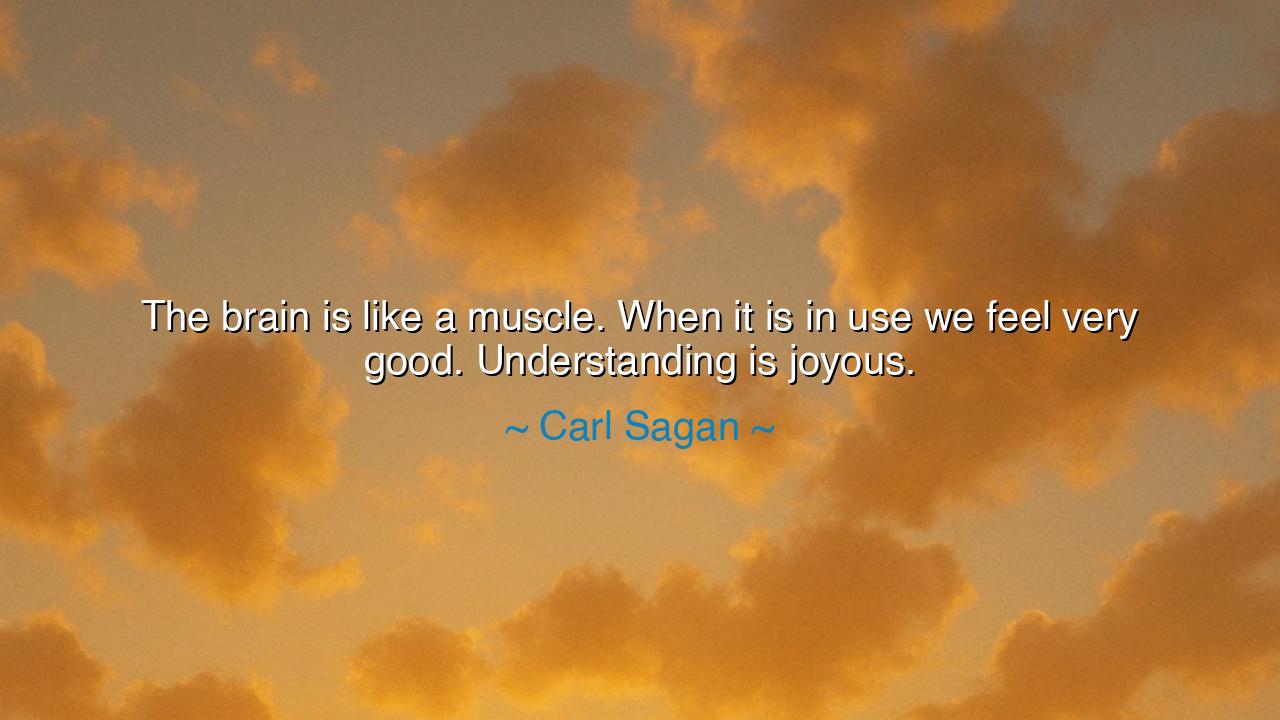
The brain is like a muscle. When it is in use we feel very good.
The brain is like a muscle. When it is in use we feel very good. Understanding is joyous.






The words of Carl Sagan, the cosmic philosopher, shimmer with both simplicity and grandeur: “The brain is like a muscle. When it is in use we feel very good. Understanding is joyous.” In this truth, Sagan speaks not only as a scientist but as a sage of the modern age. He reminds us that the pursuit of understanding is not merely a duty of the intellect—it is nourishment for the soul. Just as the warrior feels the strength of his arm grow through labor, so too does the mind find its vitality through the exercise of thought. When we think, question, and learn, we awaken a primal joy—the joy of being truly alive.
In the ancient world, wisdom was not entertainment; it was a sacred fire. The philosophers of Greece, the mystics of the East, the poets of every age—all knew that learning is an act of worship, a communion with truth itself. Sagan, heir to this lineage of seekers, clothed ancient wonder in the garb of modern science. To him, the brain was the temple of curiosity, and understanding the light that filled it. Just as muscles atrophy when left unused, so too does the mind wither when denied thought. The soul that refuses to question slowly forgets how to live.
Think of Leonardo da Vinci, that restless flame of the Renaissance. His mind was always in motion—dissecting, painting, experimenting, dreaming of flight. He did not study to impress others; he studied because he could not bear ignorance. His joy came not from mastery, but from discovery—from the living act of inquiry. Each idea was a spark, each experiment a heartbeat. Leonardo’s genius was not a gift from the heavens—it was the fruit of a mind ceaselessly exercised, a brain trained like a muscle, growing stronger through curiosity and discipline.
Sagan’s wisdom, though spoken in modern times, carries the weight of eternal truth: understanding is joyous. It is joy born not of comfort but of revelation. When one grasps the pattern behind chaos, the order within mystery, the heart leaps. It is the same joy that moves the mathematician upon solving a problem, the artist upon seeing beauty revealed in form, the child upon asking, “Why?” and discovering an answer. Such joy does not fade—it deepens. For every understanding opens the door to greater wonder, every answer leads to new questions.
Yet in this age of ease and distraction, many have forgotten that the mind must be exercised. Just as a body grows soft without movement, the intellect falters when left idle. We feed our appetites but starve our curiosity. Sagan’s voice, calm and cosmic, calls us back to discipline—not the cold discipline of duty, but the radiant discipline of passion. To think deeply, to read widely, to question bravely—these are not burdens; they are blessings. Through them, we rediscover the ancient delight of consciousness itself.
Consider also the humble story of Michael Faraday, born into poverty, self-taught, and hungry for knowledge. With no wealth but curiosity, he attended lectures from the shadows, copied books by hand, and built his own instruments. His brain, though untrained by schooling, grew mighty through use. In time, his experiments with electricity illuminated the world. Faraday’s life was living proof of Sagan’s truth: when the mind is in motion, joy becomes power, and even the unknown becomes a playground.
So let this be your teaching: use your mind boldly. Seek to understand—not for glory, but for the quiet ecstasy that comes with awakening. Exercise your curiosity as the athlete trains his body. Read not only to know, but to feel the expansion of being. Ask questions that frighten you; pursue ideas that stretch you. Each time you grasp a new truth, you will feel the pulse of life quicken within you. For understanding is not only joyous—it is freedom itself.
And when doubt whispers that the world is too vast to comprehend, remember Sagan’s gentle promise: you are made of the same atoms as the stars. Your brain, your humble muscle of thought, was born from the universe’s own desire to understand itself. To think is to participate in creation. To learn is to live in harmony with the cosmos. And in that sacred harmony, joy is eternal.






AAdministratorAdministrator
Welcome, honored guests. Please leave a comment, we will respond soon